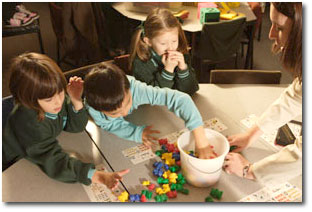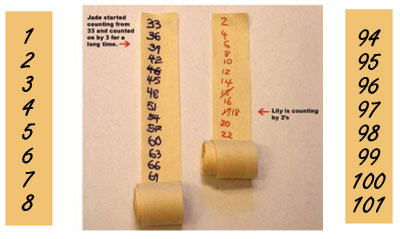Counting with Two Digit Numbers: 1.25
Supporting materials
- Related Progression Points
- Developmental Overview of Numeration: Base Ten and Place Value Properties (PDF - 28Kb)
Indicator of Progress

Students can count up to 100 objects.
To do this successfully, students need to learn the number names, and to develop systematic methods for accurately counting large collections. These will generally use the base ten structure of the number system.
Illustration 1: Irregular number names
Some students confuse 'teen' and 'ty' number words. For example, when counting aloud by ones from 12 to 20, some students might say: twelve, thirty, forty, fifty, sixty, seventy, eighty, ninety. There is often a slight hesitation before the student says twenty or one hundred.
Illustration 2: Bridging across decades
Students will find bridging across decades difficult. For example, counting from 29 to 30 is a difficult transition and students often follow twenty-nine with twenty-ten. Not really wrong of course, but not the usual number name!
Counting backwards makes these transitions even harder. For example to go from 30 to 29, the student needs to not only think that the twenties come before the thirties, but also to go to 29 rather than just 20.
Illustration 3: Counting large collections
Students need efficient strategies to count large collections of objects, especially grouping into tens. Before they acquire these strategies, students will probably count by ones, making errors by losing their place and not being able to check efficiently.
Illustration 4

Examples of the types of tasks that would be illustrative of counting concepts with two digit numbers, aligned from the Mathematics Online Interview:
- Question 1 - Estimate and count teddies scooped into a cup (holding at least 20)
- Question 2 (a) (b) - Counting by 1s
- Question 2 (e) - Count backwards from 10
Teaching Strategies
The teaching challenge here is to extend students' factual knowledge (the names of numbers), conceptual understanding (linking number names to base ten and place value properties) and strategic skills (to plan methods of counting efficiently). As with numbers to 20, the irregularity of English is a source of difficulty.
Activity 1: Verbal sequence assists students to extend their verbal counting sequence, especially bridging the decades.
Activity 2: 'What's missing?' helps students to move away from rote learned sequences to begin counting from any number.
Activity 3: More efficient strategies for counting assists students to develop efficient strategies for counting large numbers of objects.
Activity 4: Number rolls is a favourite with children learning to count.
Activity 1: Verbal sequence
Learning the number names to 100 is done is conjunction with developing place value and base ten knowledge.
Students will first learn to count and read two digit numbers (in the teens, twenties and possibly beyond) without explicit attention given to the grouping into tens. For example, when young children see 24, they see it only as 'twenty four' and probably as the number after twenty three, but not as 2 tens and 4 ones.
Later the base ten understanding begins as they learn to count by tens (ten, twenty, thirty, etc.) and then to fill in the numbers between (e.g. first learn forty, fifty, sixty etc and then forty one, forty two etc.).
Reading and writing numerals is developed simultaneously with the higher verbal sequence.
A hundreds chart is a very flexible visual aid to support verbal work. It is particularly important because the numbers are arranged in groups of ten, so the base ten patterns are evident.
The most difficult aspect of counting to 100 is bridging the decades (for example, from 59 to 60), so this needs additional attention.
Teachers should be encouraged to take every opportunity for counting together both out loud and silently, with and without moving or touching objects, with and without writing numbers etc.
Activity 2: 'What's missing?'
'What's missing?' is an activity that can be used for many counting tasks. A hundreds chart (download below), on the wall or made with tiles on a frame, provides the number sequence in order. Ask the student to look away while you turn one number face down/hide it/turn tile over. Ask the child to say what number they think is missing then let them check. This can be extended to hide adjacent sets of numbers, rows of numbers, etc.
There are many patterns on the hundreds chart that support these activities.
|
1 |
2 |
3 |
4 |
5 |
6 |
7 |
8 |
9 |
10 |
|
11 |
12 |
13 |
14 |
15 |
16 |
17 |
18 |
19 |
20 |
|
21 |
22 |
23 |
24 |
25 |
26 |
27 |
28 |
29 |
30 |
|
31 |
32 |
33 |
34 |
35 |
36 |
37 |
38 |
39 |
40 |
|
41 |
42 |
43 |
44 |
45 |
46 |
47 |
48 |
49 |
50 |
|
51 |
52 |
53 |
54 |
55 |
56 |
57 |
58 |
59 |
60 |
|
61 |
62 |
63 |
64 |
65 |
66 |
67 |
68 |
69 |
70 |
|
71 |
72 |
73 |
74 |
75 |
76 |
77 |
78 |
79 |
80 |
|
81 |
82 |
83 |
84 |
85 |
86 |
87 |
88 |
89 |
90 |
|
91 |
92 |
93 |
94 |
95 |
96 |
97 |
98 |
99 |
100 |
|
101 |
102 |
103 |
104 |
105 |
106 |
107 |
108 |
109 |
110 |
|
111 |
112 |
113 |
114 |
115 |
116 |
117 |
118 |
119 |
120 |
- Hundreds Chart (PDF - 14Kb) - PDF document with three different versions of a Hundreds Chart (1-120, 1-100, 0-99)
Activity 3: More efficient strategies for counting
Students need plenty of practice to develop efficient strategies to count large numbers of objects. There is much more involved than counting small numbers.
A large number of Unifix blocks are placed on the table. Students estimate (best guess) how many blocks there are altogether. They are then set the task of counting them. Initially they count, or attempt to count the number of Unifix by ones. However, soon students realise they could join ten Unifix together and then count by tens rather than by ones. This is more efficient and more likely to be correct, and easier to check.
Initially the estimate will be guesses, but with practice students will become quite proficient at estimating the number of Unifix. They develop a better idea of how big numbers are.

Students need to learn to group into tens in many contexts. For example if counting a large number of objects students must learn to group in tens. This will commonly occur with coins. An efficient strategy is to make piles of ten, then count the number of piles, then include the remaining objects not in a pile. To efficiently count money, make piles of 10 coins of the same denomination, and then count the number of piles, and then add the ones left over. This enables easy checking and calculating.
Activity 4: Number rolls
Buy long strips of paper (e.g. paper rolls for cash registers from a newsagent, or wide streamers). Children write numbers starting at 1 and continuing for as long as they like. Many children will love the patterns that they see emerging, and will be fascinated as they go higher and higher.
A calculator is a good support to help children find out the next number, e.g. as they go past 999 etc. Students can add 1 using +, or they can use the repeated addition sequence (1+1 = = = = = which produces numbers in order).
At this stage, it is not important that students can read out each numeral, or have a strong idea of place value etc. The idea is simply to see the patterns that emerge in the number sequence. If they reach a large number though, they will have a good idea of how big it is, because they know how far it is along the number roll.
Decorate the classroom with the number rolls and talk about the patterns that children see. This is also a good homework activity.
Some children will like to make number rolls counting in 2s or 5s or 10s etc.

Other languages
The number names up to 100 in English are irregular. Other languages name numbers logically and with an emphasis on base ten. For example, in Asian languages, names of the numbers are constructed logically using the same rule at each stage.
Examples:
- the name of the number 43 is (in translation) 4 tens and 3
- the name of the number 17 is (in translation) 1 ten and 7
- the name of the number 65 is (in translation) 6 tens and 5
This system stresses the base ten system and is easy to learn. What a good idea!
English is not the most irregular language. For example, in French the name of 80 is not related to 'eight tens' but is 'four twenties', 90 is 'four twenties and ten' and 95 is 'four twenties and fifteen'. So English is not the hardest!
